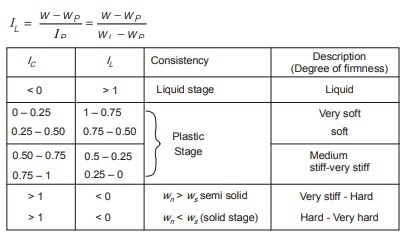Consistency of clays (Atterberg Limits)
- Consistency represents relative ease with which a soil can be deformed. It represents relative firmness of soil.
- In practice, consistency is a property associated only with fine grained soils, especially clays.
- Depending on percentage water content, four stages of consistency are used to describe the state of a clayey soil:
1. Solid State
2. Semi Solid State
3. Plastic State
4. Liquid State - The boundary between any two states is called consistency limit. They are also known as Atterberg limits after Swedish scientist Atterberg, who first demonstrated the significance of these limits.
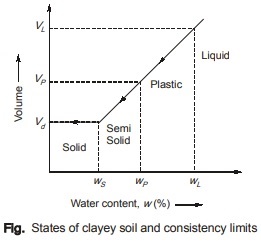
Vd = Volume of dry soil mass
= Volume of soil at shrinkage limit
VP = Volume of soil at plastic limit
VL = Volume of soil at liquid limit
wL = Liquid limit
wP = Plastic limit
wS = Shrinkage limit
Slope, dy / dx = constant
VL – VP / WL – WP = VP – Vd / WP – Ws
- For change in water content corresponding to change in degree of saturation from 0 to 100%, there is no
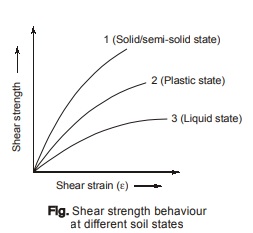 change in total volume of soil. But for water content increasing greater than shrinkage limit (S = 100%), then with change in water content total volume of soil also changes.
change in total volume of soil. But for water content increasing greater than shrinkage limit (S = 100%), then with change in water content total volume of soil also changes. - At shrinkage limit all the pores of soil are just filled by water. Hence degree of saturation (S) is 100%.
- Naturally existing soils have water content between wL and wP.
- On increase in water content shear strength of soil decreases.
Liquid Limit (wL)
It is that minimum water content at which soil has tendency to flow. At liquid limit, consistency of soil changes from plastic state to liquid state.
At liquid limit all soils have nearly negligible shear strength of 2.7 kN/m2 approximately.
Determination of Liquid Limit:
Liquid limit is found out by the following two methods:
(a) Casagrande’s apparatus.
(b) Cone penetration.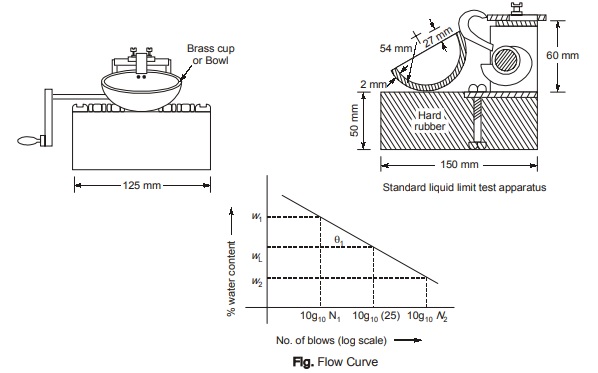
(a) Casagrande’s apparatus
- About 120 g oven dried soil passing through IS sieve 425 micron is taken and mixed with water (say w1 %) to attain putty like consistency.
- Paste is placed inside casagrande apparatus cup and levelled.
Two types of grooving tools are used for cutting:
(a) Casagrande tool which cuts a groove 2 mm wide at the bottom of soil and 11 mm at the top of soil.
(b) ASTM tool which cuts a groove 2 mm wide at the bottom 13.6 mm wide at the top of soil. For a soil of low plasticity, the ASTM grooving tool is preferred. - A groove of 2 mm size is cut and apparatus is given blows over a rubber pad and no. of blows required to close the 2 mm groove is noted as N1.
- Now same soil is mixed with water content w2 and no. of blows required to close the 2 mm groove is noted say N2.
- Same process is repeated with different water contents.
- A graph is plotted between % water content and number of blows in semi log scale.
- The above curve is called flow curve and the slope of above curve is called flow index (If).
If = tan θ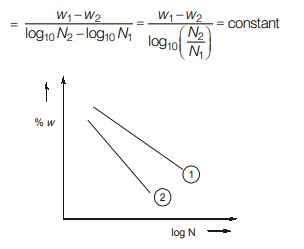
- Liquid limit is the water content corresponding to 25 number of blows.
- If a soil has greater flow index, it means that the rate of loss of shear strength with increase in water content is high.
- Curve 1 has larger shear strength.
Curve 2 has lower shear strength.
Plastic Limit (wP)
- The water content at which soil sample changes from semi-solid to plastic state is known as Plastic Limit.
- Plastic limit is also defined as the minimum water content at which soil would just begin to crumble when rolled into a thread of approximately 3 mm diameter.
- Clays have high plastic limit and liquid limit. But liquid limit is very-very less as compared to plastic limit.
- Coarse grained soil like sand and gravel have less liquid limit and plastic limit generally,
| Type of soil | Liquid limit (wL) | Plastic limit (wP) |
| Black cotton soil | 400 – 500% | 200 – 250% |
| Alluvial soil (sand) | 10 – 50% | 10 – 15% |
- Plastic limit depends upon amount and type of clay mineral in soil. Hence clay containing fine soils have more plastic limit.
Shrinkage Limit (ws)
- A state when the decrease in moisture content leads to solid state, no change in volume of soil mass is observed, the consistency of soil changes from semi-solid to solid state. The boundary water content is called shrinkage limit.
- Shrinkage limit is the smallest value of water content at which soil mass is completely saturated. It means that below shrinkage limit, soil is partially saturated.
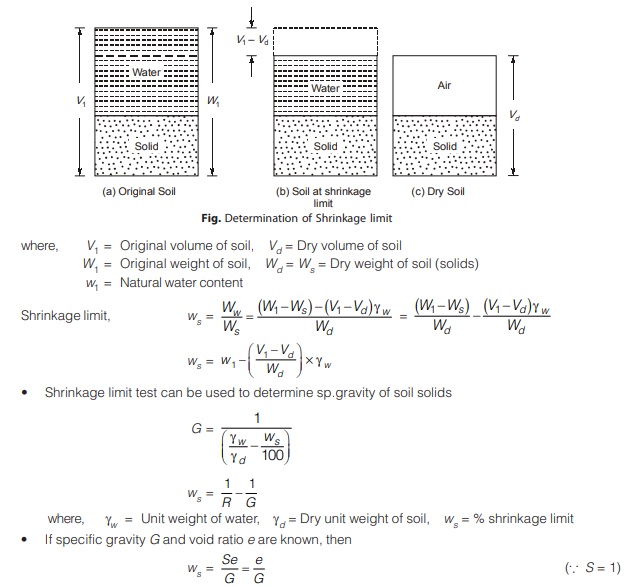
Plasticity Index
- It is the range of moisture content over which a soil exhibits plasticity. It is equal to the difference between LL and PL.
IP = wL – wP
wL = Water content at L L
wP = Water content at P L - This is due to presence of clay minerals.
- For coarse grained soils, there is no plastic zone. Hence LL coincides with PL
IP = 0 - If PL ≥ LL, then IP is reported as zero. IP can never be Negative
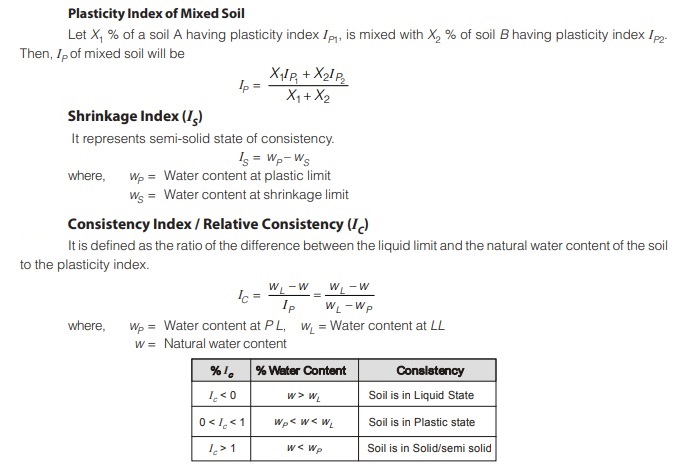
Liquidity Index (IL)
It is defined as the ratio of the difference between the natural water content of a soil and its plastic limit to its plasticity index.
